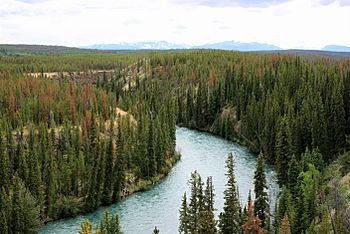Chilko River facts for kids
Quick facts for kids Chilko River |
|
|---|---|

Chilko River and cliffs made of lava flows and ash beds from former extensive volcanic activity in this region.
|
|
| Country | Canada |
| Province | British Columbia |
| Physical characteristics | |
| Main source | Chilko Lake Chilcotin Plateau 1,166 m (3,825 ft) 51°37′33″N 124°8′30″W / 51.62583°N 124.14167°W |
| River mouth | Chilcotin River Upstream from Bull Canyon 739 m (2,425 ft) 52°5′47″N 123°27′37″W / 52.09639°N 123.46028°W |
| Length | 75 km (47 mi) |
| Basin features | |
| Basin size | 6,880 km2 (2,660 sq mi) |
| Tributaries |
|
The Chilko River is a 75-kilometer (47-mile) long river in the Central Interior of British Columbia, Canada. It flows northeast from Chilko Lake until it joins the Chilcotin River. The Chilko River is a very important part of the Chilcotin River system. Its main helper river is the Taseko River.
About the Chilko River
The Chilko River is the main tributary, or feeder river, of the Chilcotin River. In fact, where they meet, the Chilko River is actually quite a bit larger than the Chilcotin.
The Chilko River is also the main reason why the lower parts of the Chilcotin River are very silty. This means the water carries a lot of fine dirt and rock particles. The Chilko gets most of its silt from the Taseko River. The Taseko River joins the Chilko a few kilometers before the Chilko reaches the Chilcotin River.
What Does the Name Mean?
The name "Chilko" comes from the Tsilhqotʼin language. The original name is Tŝilhqóx, which means "ochre river." Ochre is a natural clay earth pigment, usually yellow, orange, or red.
The related name of the Chilcotin River comes from the Tsilhqotʼin people. Their name means "people of the ochre river." This shows how important the river and its unique color were to the local Indigenous people.
See also
 In Spanish: Río Chilko para niños
In Spanish: Río Chilko para niños

